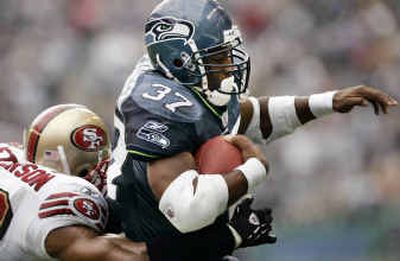Carries carry huge weight

KIRKLAND, Wash. — Statistics are notoriously pliable. With the right massaging and selective omissions, they can be used to say anything.
There are limits, of course.
It would be impossible, for instance, to crunch the numbers in such a way that one might think Seattle Seahawks running back Shaun Alexander had been featured with any prominence in recent game plans.
The numbers from the defeat Sunday at Arizona create the opposite impression. Alexander carried the ball 12 times in 56 plays, even while quarterback Matt Hasselbeck suffered through the worst game of his career.
Coach Mike Holmgren has vowed more involvement for Alexander, who carried at least 20 times in 14 of 17 games last season.
Alexander has reached 20 carries twice in six games this season, with 17- and 19-carry games falling just short of the mark.
The game against Arizona came a week after Alexander carried 16 times at New England. He averaged 4.8 yards a carry in each of those games.
“What I have to do is try to get him the ball more,” Holmgren said this week as Seattle prepared to play Carolina today.
The Panthers rank fifth against the pass but 28th against the run.
Their All-Pro right defensive tackle, Kris Jenkins, is out for the season. His replacement, 2003 fifth-round draft choice Kindal Moorehead, will line up against Steve Hutchinson, widely viewed as Seattle’s best run-blocking guard in history.
If ever there were a time to give the ball to Alexander more than a dozen times, this would seem to be the week.
The 25-17 loss at Arizona seems to make that case even without supporting evidence.
Seattle dropped back to pass 14 times in 20 first-down situations. Those plays produced three completions totaling 17 yards, eight incomplete passes, two interceptions and an unplanned 9-yard scramble.
Alexander carried six times on first down.
Counter to tradition, Seattle prefers to set up its running game by making teams fear the pass. Holmgren has made the strategy work famously, including when Seattle fielded the NFL’s sixth-ranked offense last season.
“If you look in years past, the team that had the rushing leader is not the team that typically winds up in the championship game or in the playoffs,” Holmgren said. “You can have a wonderful runner and it will help you have a good season.
“But to get to the final prize, typically that’s not the way it is. In this league, they can jam the box with extra people and make running – I don’t care who you are – very, very difficult for you.
“Until you prove you can back them off throwing the ball, they will continue to do that. So, you strive for some sort of balance.”
Holmgren’s pass-first strategy worked until recently because Hasselbeck ranked among the league’s most efficient quarterbacks.
But with Hasselbeck throwing one touchdown with six interceptions in the past two games, the running game isn’t getting much help.
Alexander beat the Cardinals for a 34-yard run on a second-and-5 play, but three other runs lost a total of 15 yards.
Nothing worked right.
In a perfect world, Holmgren would run the ball about 40 percent of the time.
This year, the Seahawks ran 52 percent of the time in their first four games. The inflated percentage reflected games when Seattle ran time off the clock to protect leads.
Last year, as the Seahawks won 10 games for the first time since 1986, the team ran the ball at a 48 percent clip.
Seattle ran the ball 28 percent of the time in its last two games.
Alexander, for his part, has not pushed the issue in public.
“This is a team game,” Alexander said. “We’ll talk about the stuff we want to do, prepare for Carolina, and just take what they give us.”
In past seasons, Alexander has said he needs about 25 carries to be most effective.